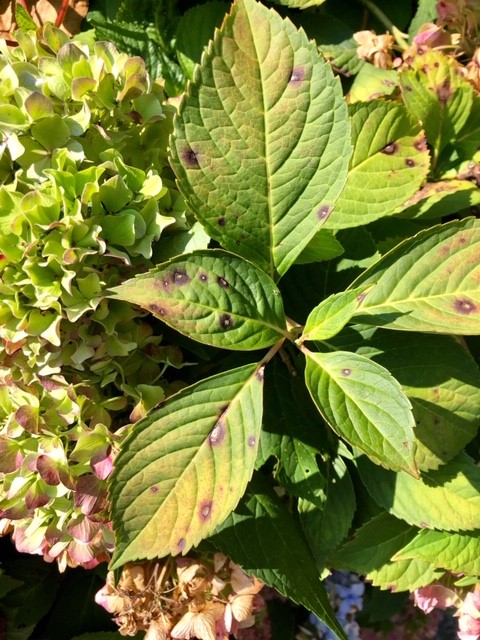Some Ideas on Hydrangea Leaves Turning Yellow You Need To Know
Wiki Article
The Single Strategy To Use For Hydrangea Leaves Turning Yellow
Table of Contents3 Simple Techniques For Hydrangea Leaves Turning YellowSome Known Incorrect Statements About Hydrangea Leaves Turning Yellow Getting My Hydrangea Leaves Turning Yellow To WorkThe Greatest Guide To Hydrangea Leaves Turning Yellow
One opportunity is that the plant is not obtaining adequate sunlight. Throughout the wintertime months, the days are shorter, and the sunlight is not as extreme, so make sure to position your Hydrangea in a place where it will certainly access least 6 hours of sunlight every day. One more factor for Hydrangea yellow leaves in wintertime might be excessive water.The leaves could be transforming yellow due to temperature stress and anxiety. Hydrangeas like cooler temperatures, so if the plant remains in a place that gets as well warm or also cool, the leaves will certainly transform yellow. If you assume temperature tension could be the problem, try moving your Hydrangea to a various area or shielding it from the elements with a cloth cover.
New development will certainly be observed in very early springtime, when you'll see environment-friendly vegetation sprouting from stems that could have shown up dead. Nevertheless, if your fallen leaves are turning brownish in spring or summertime, there are likely various other factors at play. The exact reasons depend upon the variety and their expanding problems, however in basic, brown hydrangea fallen leaves suggest dehydration and wilting in the heat
In the springtime when the mercury remains reasonably low, they'll do fine. When things warm up over the summertime nevertheless, time invested in the early mid-day rays can trigger unimaginable damage.: Grow your hydrangeas in a place where they'll get sunshine in the early mornings or evenings, yet not throughout the peak hours.
The Hydrangea Leaves Turning Yellow PDFs
Wilting is brought on by absence of wetness, suggesting there are a couple of excellent methods to make use of to avoid this from taking place. Give your hydrangeas a healthy glug of water every couple of days when the temperature levels are climbing high, and treat the dirt to much better preserve dampness. After sprinkling, a bit of mulch around the base of each plant must aid with this by maintaining wetness in the dirt.This disrupts fungi spores from working out. "The Botrytis fungus flourishes in trendy and damp problems, so stay clear of bathing the entire plant when sprinkling and simply water at the origins," shares Roy Nicol, a Master Horticulturist - Hydrangea Leaves Turning Yellow. If you've missed the chance for prevention and are taking care of an infection you should eliminate all dead or severely contaminated leaves from the plant and destroy them to avoid more spread
As a general guideline, we advise getting rid of fallen leaves when they are 50% brownish or greater. While browning created by any type of factor can not be reversed, taking the corrective action defined above will encourage the plant to grow brand-new fallen leaves so the harmed fallen leaves either drop off naturally or can be removed by the gardener.
Hydrangeas click for source must be watered only when the leading couple of inches of dirt are dry, and ought to be offered a detailed saturating each time. Underwatered hydrangeas are most likely to have yellow, wilting, and drooping fallen leaves. Increase the regularity and quantity of watering for your shrub to aid fix this concern. Hydrangeas favor fairly wet (but not soaked) soil, so give the roots an excellent saturating and allow water to be absorbed into the soil before using much more.
The Single Strategy To Use For Hydrangea Leaves Turning Yellow
The means you deal with hydrangea leaves turning yellow relies on the key issue creating the yellow leaves. This can be tough to identify, but once you do you will have the ability to readjust your plant treatment appropriately to look after the problem. As pointed out in the past, a common issue with hydrangeas is nutrient shortages.During the top expanding period, you need to water at a price of concerning 1 inch per week. If you are fretted about not effectively sprinkling your hydrangeas, there are a number of things you can do. Including compost to the base of the plants over the origin zone help to manage the temperature around the bush and maintain water in the soil.

If it is also severe, some plants will never recuperate from transplant shock and will certainly continue to decrease until they die. Minimize check this site out transplant shock by consisting of as numerous origins as feasible when excavating up your plant to relocate. Make certain to offer more water than typical in the weeks adhering to planting to help your plant recover and grow brand-new origins.
Some Of Hydrangea Leaves Turning Yellow
To stay clear of spreading out fungal conditions, make sure to thouroughly tidy and decontaminate any type of pruning tools prior to and after usage. You can attempt to flush the roots with water to remove excess fertlizer.
If you do not sprinkle your hydrangea plant for greater than a week, the leaves will certainly begin transforming yellow. Fungal conditions that assault the plants have a tendency to show join the roots and the fallen leaves of the plant. Among these conditions is origin rot, which makes it challenging for the plant to feed correctly.
Origin rot occurs when microorganisms use up the root cells as hosts and quit the cell from working. Otherwise looked after, this condition can ultimately result in the plant passing away. Fallen leave place is another fungal condition that can target hydrangea. It causes the fallen leaves transforming yellow and the appearance of brownish and purple spots on the fallen leaves.
Report this wiki page